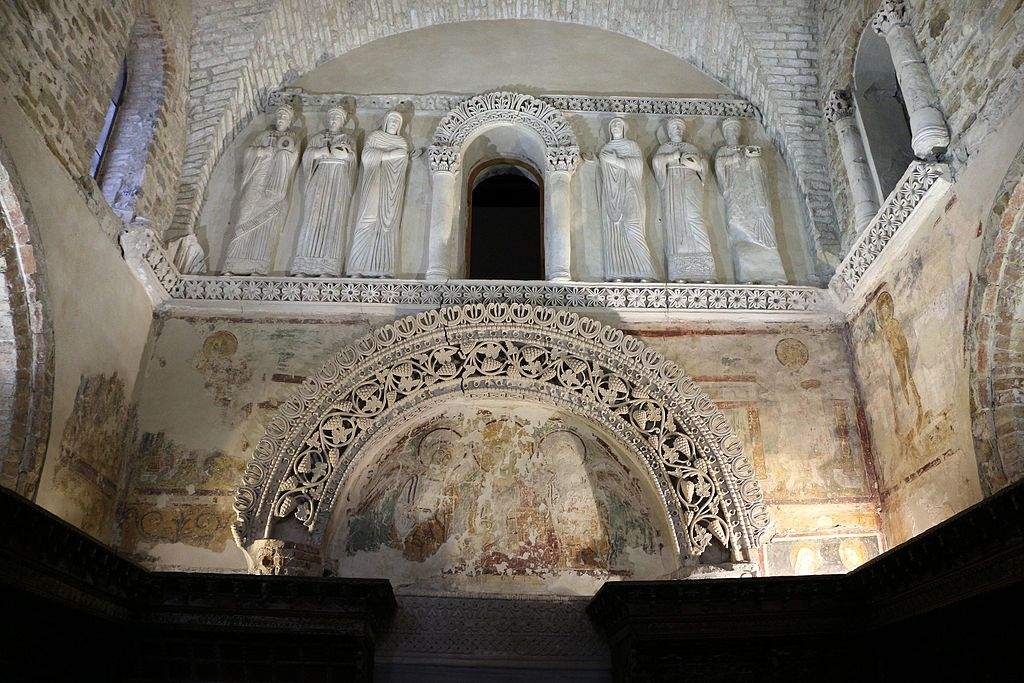Important results and discoveries from the archaeological excavation of the Lombard Temple in Cividale
Important results and discoveries are coming from archaeological excavations inside the oratory of Santa Maria in Valle in Cividale del Friuli, better known as the Lombard Tempietto. The excavations are part of an interdisciplinary set of projects for the analysis, restoration and enhancement of the Tempietto, one of the major monuments of theearly Middle Ages in Italy. It is in fact a building linked to a royal commission and the result of a unified and coherent construction and decorative phase dated to the 8th century, a time when theLombard age touched its maturity by mixing Byzantine, Oriental and Mediterranean elements in a harmony of languages. During the works, diverse interventions were carried out ranging from archaeological excavation to seismic safety, structural consolidation, restoration of the stone apparatus, all painted surfaces and stucco promoted by the Municipal Administration, the Superintendence of Archaeology Fine Arts and Landscape of Friuli Venezia Giulia and the Central Institute for Restoration of the Ministry of Culture.
These interventions differ in type, characteristics and objectives, but united by the common goal of ensuring, through knowledge, the proper conservation of the building as part of a broader project planning of restoration and enhancement of the entire complex of Santa Maria in Valle envisaged by the Management Plan of the 2010 World Heritage List - Italia Langobardorum. The Lombards in Italy - Places of Power (568-774 AD). The archaeological investigations, carried out by the company Arc-Team srl under the scientific direction of Angela Borzacconi on behalf of the Soprintendenza Archeologia Belle Arti e Paesaggio FVG, the first step in the series of interventions, were completed a few weeks ago, allowing to verify and better define the characteristics of the existing archaeological deposit.
The excavations involved the entire hall of the Tempietto and part of the apsidal area, highlighting a situation extremely compromised by repeated excavations conducted in the past that have affected the original stratigraphy: interventions that, from medieval times onward, have characterized all the phases of use of the building, with repeated lowering of the floor level, up to the numerous archaeological explorations that followed from the late nineteenth century to the 1970s. So it was a very difficult excavation due to the presence of significant rehashes, necessary, however, to record any evidence and read it in the light of currently available scientific data, also in relation to the results of recent investigations carried out in the area of the Monastery, with a view to elaborating new knowledge data.
It was then possible to identify remnants of still-preserved stratigraphy that, together with a series of carbon dating (currently in progress) and the study of the archaeological materials found, will be able to support both the chronology of the building phases related to the building and the settlement dynamics prior to the construction of the Tempietto. Indeed, the recognition of some masonry related to a building pre-existing the Tempietto, already known from previous excavations but never properly documented and understood, is interesting. These are structures defining articulated spaces of a certain width, paved with preparations of thick and tenacious mortar that would seem to presuppose the use of heavy stone slabs (perhaps the same ones later used for the Tempietto’s floor plan, still visible today). Valuable elements that, combined with the opus sectile, lent themselves to frequent reuse in connection with the gradual raising of floor plans used during the life stages of the oratory.
We do not know what this preexistence, which seems to have some monumental evidence, refers to, but it seems reasonable to link it to the ancient Gastaldaga, the seat of the Lombard ruling class. Part of that context must later have been obliterated by the construction of that extraordinary cult building used as a palatine chapel erected in the mature Lombard age, perhaps in conjunction with a general monumentalization of the power complex, later incorporated into the monastery mentioned in the sources from the 9th century onward. Tradition has it that the latter was founded by Piltrude, abbess of the Salt Monastery of Povoletto, whose remains were related to relics discovered in the 13th century during some work on the presbytery of the oratory of Santa Maria. Discovery that, because of the strong ideological connotations assumed in that thirteenth-century phase of renewal, significantly consolidated Piltrude’s connection with the foundation tradition.
Finally, the reconnaissance under the altar, carried out last December at the conclusion of the investigations in the Tempietto hall, brought to light a wooden box containing human remains, already known from several reconnaissances (the last of which took place in 1968) and traditionally attributed precisely to Piltrude. These remains, originally arranged in a sarcophagus assembled in medieval times by reusing sculptural pieces from the Lombard period dating to the 8th century, were moved under the altar in recent times. These are a selection of skeletal remains pertaining to several individuals, currently being studied.
Image: the interior of the Lombard Temple. Photo by Francesco Bini
 |
| Important results and discoveries from the archaeological excavation of the Lombard Temple in Cividale |
Warning: the translation into English of the original Italian article was created using automatic tools. We undertake to review all articles, but we do not guarantee the total absence of inaccuracies in the translation due to the program. You can find the original by clicking on the ITA button. If you find any mistake,please contact us.




























